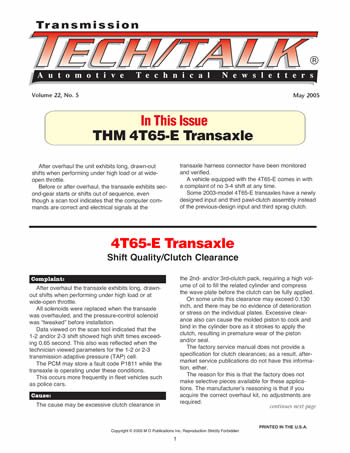July 2005 Issue
Issue Summary:
2000 and later Isuzu Trooper and BMW models with the 4L30-E transmission may exhibit diagnostic trouble code P1870 (torque-converter slip) or a shudder on TCC application.
Hyundai’s A4AF3 and A4BF2 units, used in 2000 and later Accent, Elantra and Tiburon, are almost identical to the A4AF1 and A4AF2, but with a few major exceptions.
After rebuild of a Hyundai A4AF3 or A4BF2, there is no forward movement in the Drive range, but reverse and manual low are OK. The transaxle may engage in Drive during high engine speeds, then neutral out and stop operating.
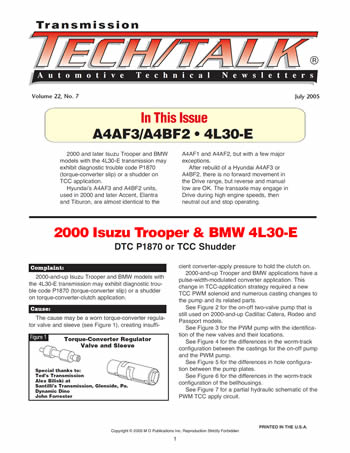
The Trooper Blues
The description for code 37 says this “serial line” is the wire that is connected from the transmission control module to the engine control module and the diagnostic connector. This wire is used for torque management. How it works: The TCM delivers a spark-advance signal to the ECM during each shift, through this serial line, to reduce engagement shock. Any interruptions, shorts or opens on this line will set a code 37.

Gear Head
Our instructor began by teaching us that a simple planetary gear set consists of 1) a center sun gear, 2) a carrier with three or more pinion gears that are free to rotate on their pins around the sun gear and 3) the internal ring gear, which meshes with the pinion gears. Then he started to say, “If you hold the internal gear stationary and drive the sun gear, you will see the pinions drive the carrier in the same direction as the sun gear but at a reduced speed with increased power.” This is where some of my fellow classmates started to get bored.
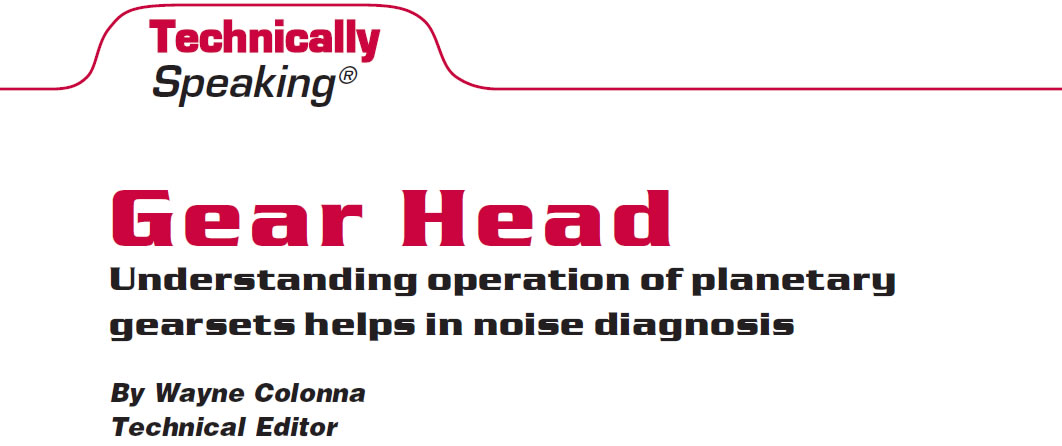
Tobacco Road
Outside sales is not a one-time task. It’s an ongoing process that allows you to identify the types and number of accounts you will want to service, to prepare the best possible sales materials, to learn techniques that get and keep your foot in the door, to handle objections so you can land the accounts and especially to visit all existing accounts periodically to make sure they continue to exist.

Getting Up to Speed
There are basically three different styles of speed sensors a transmission diagnostician has to deal with: a reed switch, an AC generator (pulse generator) and a Hall-effect sensor.
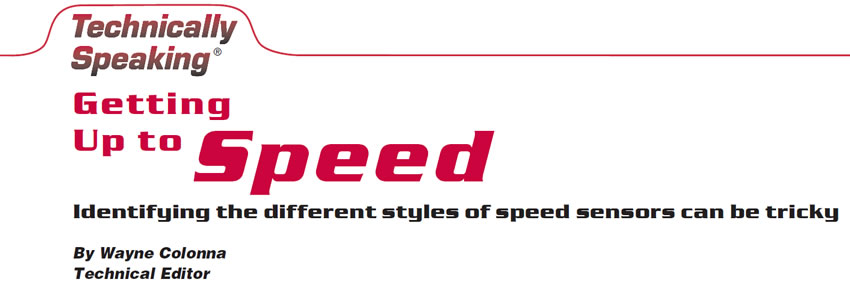
GM’s Steady-State Adapts
With a basic understanding of TAPS, the Transmission Adaptive Pressure System, covered in last month’s article, we will now try to tap into the Steady State Adapt System and what its data can tell us. Not all scan tools provide steady-state data, but I’m convinced that this information is a real help in diagnosing problems in the later GM units. Data for the examples I used in these articles was recorded on either my GM Tech2 or my Mastertech. All the units in the examples shown below are 4T65-Es.

Up to Standards
The cliché “What you don’t know can’t hurt you” is way out of date. The single most-important commodity in the world we operate in is knowledge. Information – and that means good, factual information – is the only thing that stands between us and expensive failures. Our quest for information will include a good working knowledge of the operation of the complex systems that comprise the modern motor vehicle and their relation to one another, feedback from the customer to fully understand their problem and the results they want you to achieve, and a thorough and complete observation of the vehicle you are working on.
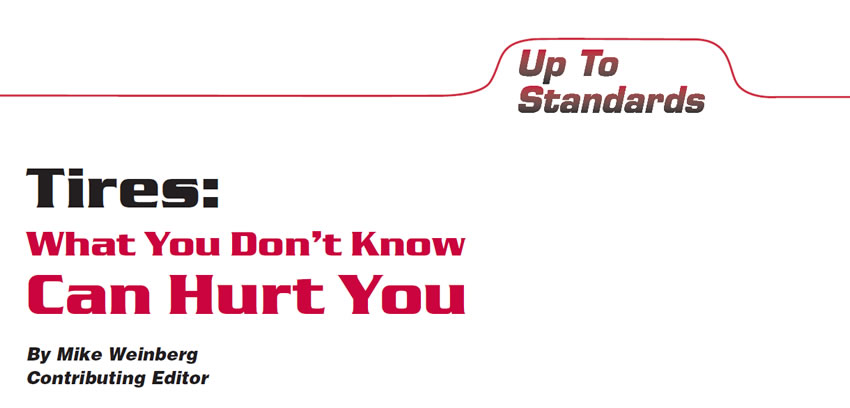
Another Cross-Connect Scenario
1998 to 2000 Kia Sportage and Sephia have the idle-air-control valve and the throttle-position sensor relatively close to each other. Figures 1 and 2 show the setup in the Sephia, which is similar to that in the Sportage.
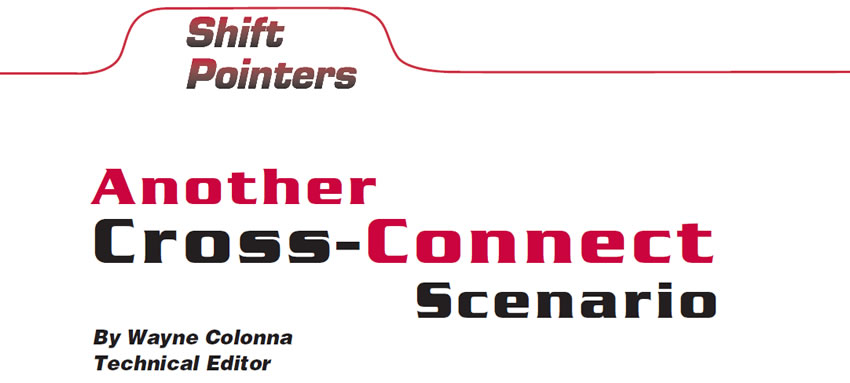
June 2005 Issue
4T65-E
Differences Between GM and Volvo Applications
The 4T65-E transmission is used both in General Motors vehicles beginning in 1997 and in Volvo 80 series starting in 1999. There are several major differences between these units that can cause some problems with parts interchangeability.
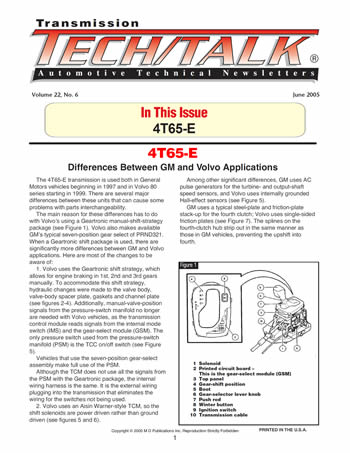
Attitude Adjustment
Every now and then we need to take a fresh look at how we are handling our businesses with respect to our customers, employees and suppliers. Are we giving them the respect and attention they deserve?

Education – Never More Critical Than Now
Yesterday I had the privilege of watching a very well-made training video by Bruce “Doc” Ginther (aka Dr. Dyno), a diagnostician and trainer to the auto-care and transmission industries. It had been quite a while since I had taken in any of that type of training, being mostly involved with sales and management these days. I must say, I was quite impressed with the simple explanations of what I always considered to be the most difficult of diagnostic problems – the electrical system.

May 2005 Issue
Issue Summary:
After overhaul the unit exhibits long, drawn-out shifts when performing under high load or at wide-open throttle.
Before or after overhaul, the transaxle exhibits second-gear starts or shifts out of sequence, even though a scan tool indicates that the computer commands are correct and electrical signals at the transaxle harness connector have been monitored and verified.
A vehicle equipped with the 4T65-E comes in with a complaint of no 3-4 shift at any time.
Some 2003-model 4T65-E transaxles have a newly designed input and third pawl-clutch assembly instead of the previous-design input and third sprag clutch.
